Content structure
In this case study, I will show you how I increased organic traffic by 167% for a client in the highly competitive printing industry and fully employed their production capacity.
And the best part?
I kept the costs in check and benefited mainly from the history of the website (even though it was not entirely rosy and I had big doubts about how the overall development of the website would behave over time).
Short brief about the client
- The client is a medium-sized screen printing company based in a small Czech town.
- It has been operating in the field of printing since 1992.
- In 2004, it fully focused on the specialization of textile screen printing, which it saw as being the future.
- Thanks to special technologies, the client is able to realize even demanding full-colour prints on textiles solved by colour separation with a daily capacity of about 8,000 prints.
The client came to me with experience of working with an SEO agency and clearly-defined SEO goals:
- Increase traffic to keywords already monitored.
- Increase conversion traffic as enquiries increase over time.
Project status before the start of the cooperation
The client’s organic traffic was approximately 1,388 users per month. After the first overall audit of the site, there were obvious shortcomings in the site’s technical state (indexing, duplication), information architecture, and overall content work – where there was virtually no work with keyword analysis.
I found out that a previous SEO agency (I won’t name names) had been almost playing with fire in link building, and putting the whole business at risk.
According to the screen below, you can see that at the turn of May/June 2018, the agency tried to artificially get backlinks, and basically gathered a lot of links from very low quality websites, which are also referred to as “PBNs”.
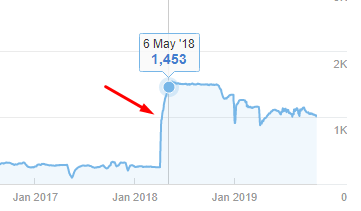
I had to take this aspect into account when working with the client, once this fact was brought to his attention. I warned him that this unfair activity could jeopardize his business.
I have been charting this situation week by week and considered taking steps to disassociate ourselves from these links. Finally, after careful consideration, I have backed away from this step.
My SEO strategy
I usually use two different SEO strategies with clients, which I tailor to their business focus and available resources.
In most cases these are:
1. Content-Driven Strategy
This is my preferred strategy, but it is one that requires significant resources, time, and effort. The client is involved in the collaboration quite often – which is usually beyond what the client can afford because they need to focus on the business itself.
The strategy is quite simple and brief:
- I create content that attracts backlinks.
- I promote content to get backlinks.
- The goal is to increase the authority of the client’s website.
2. Non-Content Based Strategy
This strategy is exactly what it sounds like. That is, we don’t create content, we promote it – except for the need to extend the information architecture of the site.
Basically, we optimize the landing pages for specific target keywords. This strategy is suitable for smaller- or medium-sized businesses with lower budgets.
Long story short:
- I perform an SEO audit and we will find out about all the technical and off-page link anomalies of the site.
- The programmers fix all the issues from the SEO audit.
- I look for suitable opportunities for new keywords, analyze the competition and then approve the keywords with the client.
- I optimize landing pages for those keywords.
- We look for appropriate link opportunities and implement them.
And that’s exactly the strategy we used for this client.
Let me show you how this process works in practice.
Step #1: Keyword Analysis
I created a keyword classification analysis to determine the most appropriate keywords for the client and their business.
Next, I conducted research to see how many keywords the client didn’t have a landing page for on their site. For those that did, I re-analyzed how they were performing in the search results and whether we were directing them to an appropriate landing page.
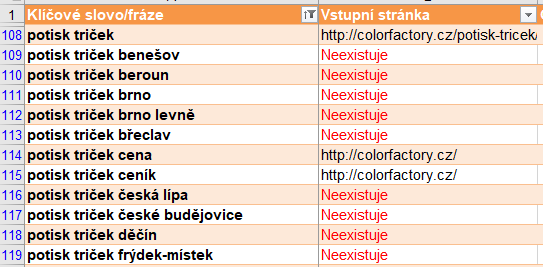
Our research identified keywords with higher search volume and lower competition.
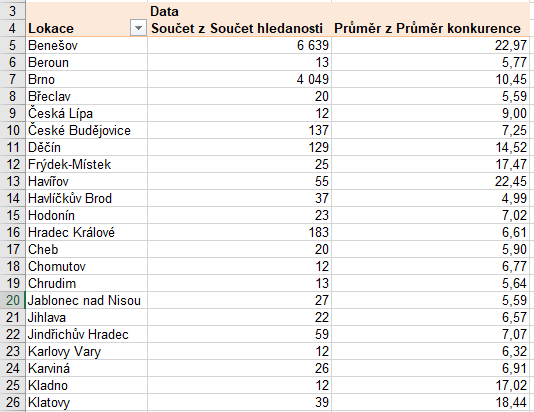
We calculate the lower competition according to a simple formula of the keyword competitiveness rate (it works with the keyword search and the number of results shown in searches for this keyword).
By selection, we discovered that location terms are the most suitable, also because of the client’s goal – i.e., to increase CONVERSE traffic.
I chose keywords like “school t-shirts”, “graduation t-shirts”, etc. as additional keywords.

Step #2: Competitor Analysis
I usually divide the competitive analysis into two phases.
In the first phase, I identify the basic metrics that I uncover in a short period of time, and then I make a simple selection of which keywords make sense to pursue.
- I check basic MOZ metrics such as the client’s DA (domain authority) and PA (page authority) in relation to the sites being evaluated (these metrics are internal MOZ calculations that are calculated by evaluating multiple factors – including, for example, the link portfolio)
- For a selected keyword, I search for strong brands on the first page of the search, which can be a sign of high competition
If the keywords pass this first stage, I move on to the second stage, which is much more complex. I analyze each competitor in the SERPs (search results) one by one.
At this stage, look at a number of factors, such as:
- Number of root domains referring to the landing page
- Quality of links referring to the competitor’s landing page
- Quality of content (based on length, structure and keyword optimization)
After that, I analyze competitors in general as a whole (domain). I focus on:
- Number of referring domains (evolution over time) – the evolution of traffic over time
- Quality of links
- Competitor visibility in SERPs (share of impressions in search results) – according to this data we can see how the site is doing in SERPs
- Distribution of the number of words on each landing page (we can see if the competitor is actively working with content)
- Brand strength (searches + mentions)
The next stage is selecting the right landing pages that we want to optimize. If there is no suitable landing page on the site, then I suggest extending the information architecture.
Landing Page-Level Optimization
I suggested that the client extend the structure of their website based on keyword analysis. This extension is a rather complex process, because everything has to be done with respect to the existing information architecture.
I used location-based terms, which I designed differently in terms of content compared to that of local SEO.
Since the company does not physically operate in these locations, but is still able to deliver to them, we structured the landing pages as references in the locations and then adapted the content accordingly, taking into account user intent (UI).
I put a lot of emphasis on the part where we had to explain in an argumentative way to the user, who had gotten to this landing page through the given location expression, why he should order production from this company, which does not physically operate in this location, but can still deliver the order at the same time.
We were able to solve with simple sales arguments, including examples of production for the location.
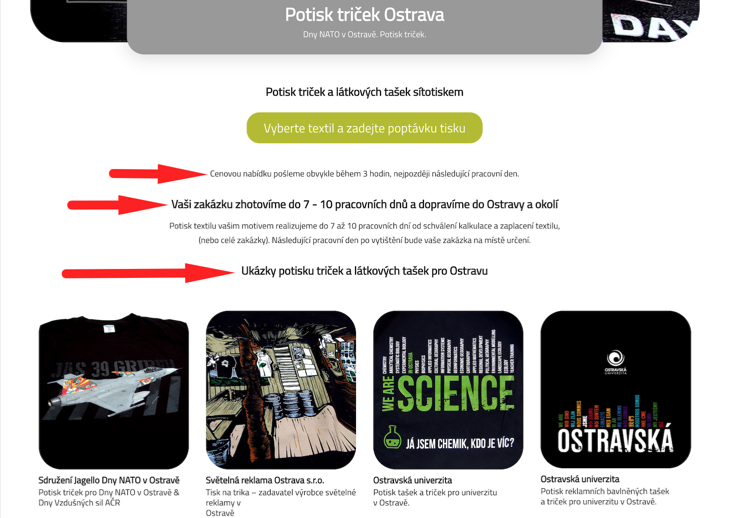
We used data on the most link-strengthened landing pages of the site (see the screenshot below) and performed appropriate internal linking to these location-based landing pages.

Results
Data from Google Analytics and organic traffic development in 6 months of cooperation.

When I started working with the client, their traffic was approximately 1,338 users per month.
After 6 months of cooperation, I increased the organic traffic to 3, 707 users per month. This is an increase of 167%.
A growing trend in the number of keywords for which the website is optimized.
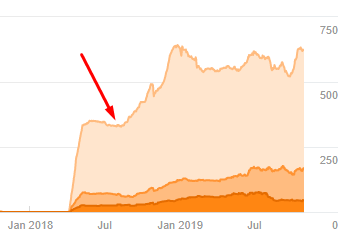
An increasing trend in the number of views and clicks on landing pages (data from Search Console).
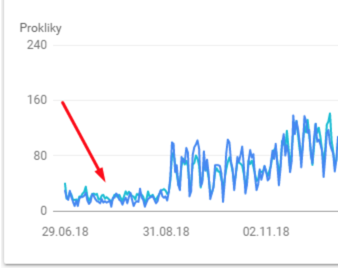
Our location-based landing pages account for up to 50% of all organic traffic – (see the abbreviated overview below)
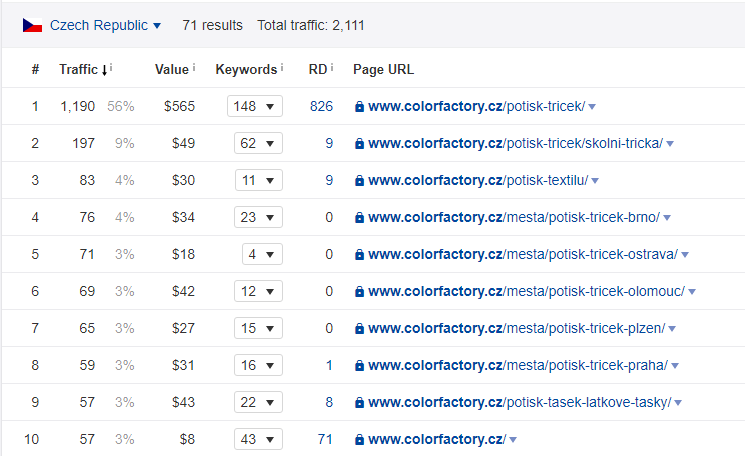
There are several conclusions that can be drawn from these results:
- It takes quite a long time to increase organic traffic to interesting numbers (6 months is often an exception depending on the history and strength of the site).
- Unless you continuously work hard on the site month after month, you will never see the fruits of your labor.
- Companies need to realize and understand that SEO is a long run.
- SEO should be combined with other marketing channels.
- Landing page conversion optimization needs to be consulted with a UX specialist.
Conclusion
Even though I detected unfair practices in the client’s backlink acquisition that could jeopardize our work and results, in the end – despite all the risks – it turned out not to be a big problem for the development of the site (the site has not stagnated in traffic even two years later).
On the contrary, we were able to take advantage of it, and did not need to push the site significantly in link building (rather marginally).
Certainly, this SEO campaign still has a lot of room for improvement, especially on the technical side of the site and overall UX collaboration. However, I always take into account the client’s time and financial possibilities.
